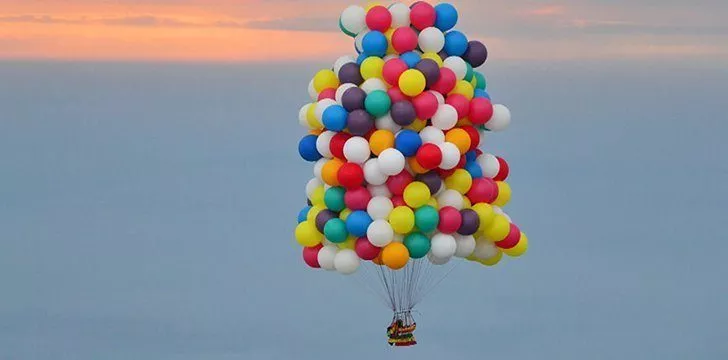Floating into the sky via a cluster of balloons is a childhood dream for many kids!
But put into real life circumstances, is it even possible?
The idea was put back into many people’s minds when the popular movie “Up” was released and the main character floated his house with hundreds of balloons.
Is any of this even possible?

There’s a science to everything, even balloons!
Some of it can be kind of boring – helium is strong enough to lift one gram per liter of helium.
So if one balloon has 5 liters of helium, that balloon can lift 5 grams.
That’s why to hold down a balloon, you can just tie it to pretty much anything, even lightweight objects.
Of course you also have to take into account temperature and pressure, but we’ll explain this in assumption that there are no odd circumstances causing fluctuation.
How many balloons would it take to float?

When it comes to floating yourself, you have a few options. Use thousands of small balloons, or hundreds of huge ones.
A standard balloon is 11 inches. To lift just one pound, you would need 37 balloons and 423 liters of helium!
The average human weight is 137 pounds. For that, you would need over 5,000 standard balloons and almost 58,000 liters of helium!
If you used a jumbo balloon measuring 36 inches, you would only need 145 balloons – but still the same amount of helium. That’s a lot of balloon blowing!
Even then, that’s only to get yourself off the ground. If you wanted some serious air, you would need even more balloons.
A Successful Attempt at flying with balloons.

There are a few people in the world who have successfully flown by use of balloons. The most notable was Tom Morgan in 2011.
It had been his dream to do something involving balloons, and that dream eventually came true.
Tom and his team encountered a few obstacles, including good weather, preventing the balloons from popping, and helium supply.
Tom attempted this feat three times in Botswana, but it failed each time.
He finally relocated to Johannesburg with the last of his helium supply and tried again.
The fourth time was the charm! It took 100 giant balloons and two days of blowing them all up. After that, it was all smooth sailing – or floating rather!
Upon a successful lift off, Tom drifted over 15 miles and reached a height of 1.5 miles high. He floated for over two hours.
As he got closer to the atmosphere, things started to become uncertain. The temperature was rising which could cause the balloons to pop. Not only that, but he was drifting quickly into a flight path!
Although nervous, Tom kept his cool and slowly had to cut balloons away in order to drift safely back to earth.
Tom was part of a group called The League of Adventurists, who were inspired by his feat and planned to start a competition based on cluster ballooning.
Recreating Disney Pixar’s “Up”.

A team from National Geographic recreated this iconic scene from Up.
In 2011 over the course of two weeks, a team created a specially designed lightweight house and floated it with 300 eight-foot-tall balloons.
And there were people inside!
The house reached 10,000 feet and flew for about an hour.
Would you ever attempt to live out this fantasy and fly via balloons? Personally, the furthest I’ll ever go is flying in a hot air balloon!











